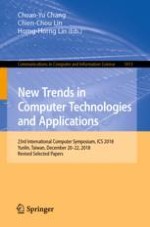2019 | Buch
New Trends in Computer Technologies and Applications
23rd International Computer Symposium, ICS 2018, Yunlin, Taiwan, December 20–22, 2018, Revised Selected Papers
herausgegeben von: Chuan-Yu Chang, Chien-Chou Lin, Horng-Horng Lin
Verlag: Springer Singapore
Buchreihe : Communications in Computer and Information Science
